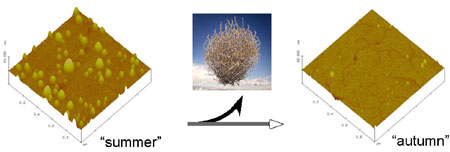06/08/2007
A nano-tumbleweed
Recent Research from Professor Xiaoyang Zhu and their research group.
Tumbleweeds grow in the Spring
and Summer and break away from their roots in Autumn “tumbling” in the desert.
You probably have seen the Hollywood version of tumbleweeds in Western movies,
usually in a deserted street, right before a gunfight (remember that tune…).
Recently, graduate student Yang Deng and Chemistry professor Xiaoyang Zhu
have discovered a nanoscopic version of tumbleweed. In a latest paper in
the Journal of the American Chemical Society (http://pubs3.acs.org/acs/journals/doilookup?in_doi=10.1021/ja0706807),
they showed that covalently tethered polymer molecule can spontaneously break
away from the surface when polymer/surface interaction is sufficiently unfavorable.
This is demonstrated in surface initiated polymerization of a hydrophilic
polymer, hyperbranched polyglycidol (i.e., the tumbleweed), from minority
surface sites embedded in a hydrophobic self-assembled monolayer (i.e., the
desert). As each hyperbranched polyglycidol molecule grows larger, it encounters
more unfavorable interaction with the hydrophobic surface and leads to spontaneous
bond rupture and desorption. This finding challenges the traditional view
on noncovalent interaction of macromolecules with the local environment at
interfaces and has broad implications for the understanding, design, synthesis,
and applications of surface tethered macromolecules. The authors are happy
with their findings and are anxiously waiting for a call from Hollywood.

AFM images (1000x1000x60 nm) of the surface before and after
the spontaneous desorption of hyperbranched polyglycidol molecules.
|